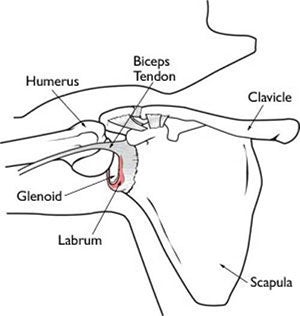
The labrum deepens the socket of the shoulder joint, making it a stronger fit for the head of the humerus.
The shoulder joint has three bones: the shoulder blade (scapula), the collarbone (clavicle), and the upper arm bone (humerus). The head of the upper arm bone (humeral head) rests in a shallow socket in the shoulder blade called the glenoid. The head of the upper arm bone is usually much larger than the socket, and a soft fibrous tissue rim called the labrum surrounds the socket to help stabilize the joint. The rim deepens the socket by up to 50% so that the head of the upper arm bone fits better. In addition, it serves as an attachment site for several ligaments.
What causes a shoulder to tear?
Injuries to the tissue rim surrounding the shoulder socket can occur from acute trauma or repetitive shoulder motion. Examples of traumatic injury include:
- Falling on an outstretched arm
- A direct blow to the shoulder
- A sudden pull, such as when trying to lift a heavy object
- A violent overhead reach, such as when trying to stop a fall or slide
Throwing athletes or weightlifters can experience glenoid labrum tears as a result of repetitive shoulder motion.
What are the symptoms of a torn shoulder?
The symptoms of a tear in the shoulder socket rim are very similar to those of other shoulder injuries. Symptoms include
- A sense of instability in the shoulder
- Shoulder dislocations
- Pain, usually with overhead activities
- Catching, locking, popping, or grinding
- Occasional night pain or pain with daily activities
- Decreased range of motion
- Loss of strength
